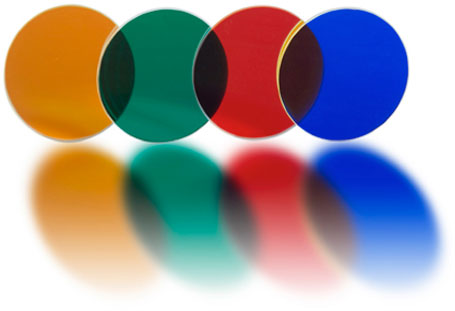 A dichroic filter, thin-film filter, or interference filter is a very accurate color filter used to selectively pass light of a small range of colors while reflecting other colors. By comparison, dichroic mirrors and dichroic reflectors tend to be characterized by the color(s) of light that they reflect, rather than the color(s) they pass.
A dichroic filter, thin-film filter, or interference filter is a very accurate color filter used to selectively pass light of a small range of colors while reflecting other colors. By comparison, dichroic mirrors and dichroic reflectors tend to be characterized by the color(s) of light that they reflect, rather than the color(s) they pass.
Dichroic filters use the principle of thin-film interference, and produce colors in the same way as oil films on water. When light strikes an oil film at an angle, some of the light is reflected from the top surface of the oil, and some is reflected from the bottom surface where it is in contact with the water. Because the light reflecting from the bottom travels a slightly longer path, some light wavelengths are reinforced by this delay, while others tend to be canceled, producing the colors seen.
Dichroic color filter coatings are an excellent alternative to dyed plastics and glass when a beam of light must be split into two distinct beams varying by wavelength.
Dichroic and color correction filters have the advantage of reflecting unwanted light instead of absorbing the energy, which allows dichroic filters to be used with much higher intensity light sources up to 550°F.
Dichroic glass coating/filters can be utilized for heat control (UV & IR) blocking, as soft and spread lenses, and for color correction.
 Dichroic filters from Abrisa Technologies are primarily used in such applications as:
Dichroic filters from Abrisa Technologies are primarily used in such applications as:
- LED color correction
- Special effects (photography)
- Entertainment (stage & theatrical lighting)
- Architectural lighting systems – mood and cosmetic enhancement (color correction) add warmth or cooler atmosphere depending upon the environment desired. For instance restaurant lighting – a warm dichroic filter is used to enhance food and atmosphere while a jewelry store would use a cool filter to enhance sparkle and shine of the gems.
- Museum
- Retail
- Restaurant
- Casino
- Residential
- Outdoor
- Landscape
Dichroic filters can be utilized for heat control (UV & IR) blocking, as soft and spread lenses, and for color correction.
Available types of dichoic filters offered by Abrisa Technologies include:
- 45º reflective dichroic – (beam splitter) – Beam Splitter (BS) is a term used to describe various coatings which divide a beam of light into separate beams. Dichroic filters are often called beam splitters. In this section, we will be describing beam splitters that divide light at each wavelength of interest into two separate beams.
- Additive & subtractive color filters – (blue, red, green, cyan, yellow, magenta, orange)
- Longpass (Trim Filter or LWP) – Long pass filters block a select band of shorter wavelengths. This example, long wave pass cutoff filter provides average reflectance more than 99% from 400-700nm, 50% cutoff point at 750nm ±10nm and 95% transmission from 780-1200nm.
- Shortpass (Trim Filter or SWP) – Short pass filters block a select band of longer wavelengths. This example, short pass filters block a select band of longer wavelengths. Short wave pass cutoff filter passes light from 325-450nm and blocks visible light from 500-700nm. It has a 50% point at 470nm ±10nm.
- Bandpass – These filter coatings transmit varying wavelength bands, which are determined by two cutoff wavelengths. Filters can be made at any given wavelength from near ultraviolet to near infrared.
- Notch (Minus) Filter – Notch filters block a relatively narrow band of wavelengths between shorter and longer pass bands.
Advantages of Dichroic Filters:
- Much better filtering characteristics than conventional filters
- Ability to easily fabricate a filter to pass any band pass frequency and block a selected amount of the stop band frequencies (saturation)
- Because light in the stop band is reflected rather than absorbed, there is much less heating of the dichroic filter than with conventional filters
- Much longer life than conventional filters; the color is intrinsic in the construction of the hard microscopic layers and cannot “bleach out” over the lifetime of the filter (unlike for example, gel filters)
- Filter will not melt or deform except at very high temperatures (many hundreds of degrees Celsius)
Abrisa Technologies has over 160 different color filters available. Dichroics are offered from 1.1mm (.043”) thick up to 3.3mm (1.28”) thick.